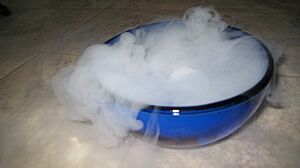Ice facts for kids
For water in its liquid state see Water

Ice is the common name for frozen water. When water gets very cold, it turns into a solid form called ice. This happens at a temperature of 0° Celsius (which is 32° Fahrenheit or 273 kelvin).
You can easily make ice at home in a refrigerator or freezer. If you put water in a freezer and leave it, it will get cold enough to freeze. Using a copper or other metal container can make water freeze faster. Metals are good at moving heat, so they help the water cool down and freeze quicker than in a plastic ice tray.
Contents
How Water Becomes Ice
Water is special because it expands when it freezes into ice. This means ice takes up more space than the liquid water it came from. Because of this, ice is less dense than water, so it floats! Most other liquids become more dense when they cool down.
Water expands by about 9% when it turns into ice. This happens because the water molecules actually move farther apart when they form an ice crystal. This arrangement makes ice lighter than liquid water.
This expansion can cause problems. If water freezes in plumbing pipes, it can make them burst. Water in glass bottles can also make them explode when it freezes. When water freezes in cracks in rocks, it can expand enough to split even hard rocks apart. This is an important natural process that helps wear down mountains and turn rock into soil.
When most materials are cooled, their molecules vibrate less and pack closer together. When they reach their freezing point, these molecules usually form a crystal-like solid. Some materials, like glass, don't form crystals but become very stiff liquids that seem solid. Only Helium won't freeze, but other liquids like cooking oil or petrol freeze at temperatures most people don't experience.
Salt Water and Ice
Salt water needs to be much colder than pure water to freeze. The ice that forms from salt water has much less salt in it than the original water. This salty ice is also not as strong as ice made from pure water.
Spreading salt on ice can make it melt, as long as it's not too cold. The salt starts to dissolve the ice, forming a salty water mixture called brine. This brine isn't cold enough to stay frozen at the same temperature, so the ice melts.
Where Ice is Found on Earth
Because ice floats, even large bodies of water like some oceans only freeze on their surface. Most lakes never freeze all the way to the bottom. Even very cold oceans, like the Arctic Ocean, only freeze on top. This allows the liquid ocean water below to keep moving.
This is very important for Earth's climate. It helps spread heat around the planet, making temperatures less extreme. If ice sank instead of floated, oceans would fill up with ice from the bottom and stay solid. A solid ocean couldn't move heat around. But because ice floats on the surface, the water underneath can keep circulating, and the surface ice can easily melt when it gets warmer. Antarctica holds most of the world's ice.
Earth's Ice Ages
Earth's climate is always changing. When it gets very cold for a long time, it's called an ice age. During ice ages, huge parts of the Earth are covered in ice, snow, and glaciers. The reasons for ice ages are quite complex.
Currently, Global warming is affecting Earth's ice resources. The causes of global warming are also very complex and are being studied by scientists.
Dry Ice
There's also something called 'dry ice'. This is frozen carbon dioxide, not water. When dry ice is exposed to normal air, it turns directly into carbon dioxide gas. This gas has no smell or color.
The gas is so cold that when it mixes with air, it cools the water vapor in the air. This creates a fog that looks like thick white smoke. Dry ice is often used in the theatre to create fake fog or smoke effects.
Images for kids
-
Frozen waterfall in southeast New York
-
Ice on deciduous tree after freezing rain
-
A small frozen rivulet
-
Snowflakes by Wilson Bentley, 1902.
-
Harvesting ice on Lake St. Clair in Michigan, c. 1905
-
Loss of control on ice by an articulated bus
-
Channel through ice for ship traffic on Lake Huron with ice breakers in background
-
Ice pier during 1983 cargo operations. McMurdo Station, Antarctica
See also
 In Spanish: Hielo para niños
In Spanish: Hielo para niños




















